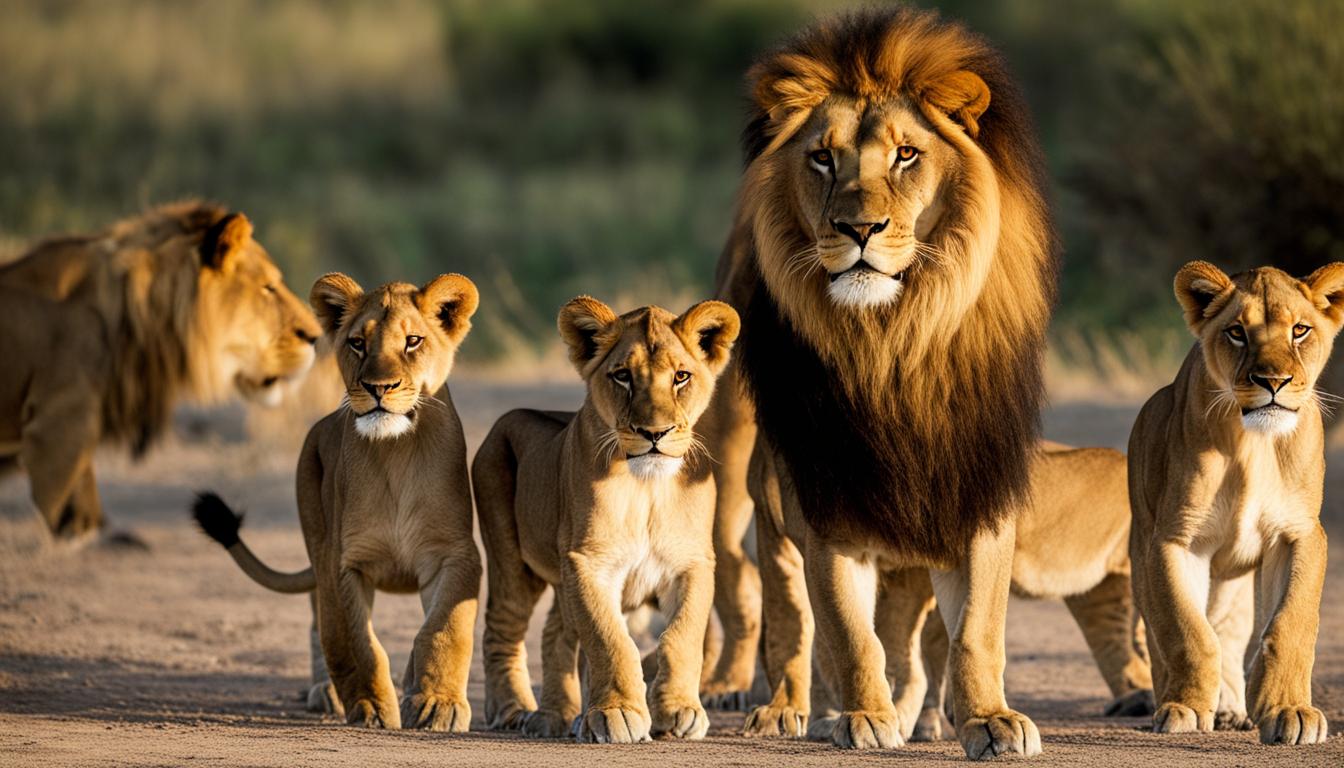Lion prides are fascinating social organizations unique to lions, setting them apart from other large cat species. Understanding the size, structure, behavior, and dynamics of lion prides is crucial for appreciating the significance of these majestic animals and ensuring their conservation and coexistence in the wild.
Key Takeaways:
- Lion prides are social organizations unique to lions.
- A lion pride typically consists of 2-3 male lions, 5-10 female lions, and their young.
- Female lions form the core of the pride and establish a matriarchal social structure.
- Male lions leave the pride around the age of three and may form or take over another pride later in life.
- Lion prides engage in cooperative hunting, primarily led by the females.
Lion Pride Size and Structure
Understanding the size and structure of a lion pride is key to comprehending the fascinating social dynamics of these majestic creatures. Lion prides can vary greatly in size, ranging from just a few individuals to as many as 40 lions. African lion prides typically consist of 2-3 male lions, 5-10 female lions, and their young. In contrast, Asian subspecies of lions divide themselves into gender-specific prides, with males and females remaining in separate groups except during mating season.
In African prides, the females form the core group and establish a matriarchal social structure. They tend to stay in the same pride throughout their lives, while male cubs leave around the age of three to either form or take over another pride later in life. This unique social structure allows for cooperation in hunting and the sharing of resources within the pride.
When examining the structure of a lion pride, it is essential to understand that each member plays a distinct role. Females take the lead in cooperative hunting, while males often patrol the pride’s perimeter to guard against intruders. This division of tasks within the pride ensures the survival and protection of the group as a whole.
Lion Pride Structure Comparison
| Aspect | African Lion Prides | Asian Lion Prides |
|---|---|---|
| Group Composition | Mixed male and female groups | Gender-specific groups, males and females separate |
| Female Dominance | Matriarchal social structure, females in core group | Less pronounced female dominance, males play a more active role in the pride |
| Male Movements | Male cubs leave the pride around age three | Male cubs may remain in the pride for a longer duration |
Comparing the lion pride structures between African and Asian subspecies reveals intriguing differences in social organization and behavior. While both types of prides have their unique characteristics, they ultimately serve the same purpose of fostering survival and cooperation within the group. By delving into the intricacies of lion pride size and structure, we gain a deeper appreciation for these remarkable creatures and their complex social lives.
Lion Pride Behavior and Communication
Lions within a pride exhibit various behaviors and rely on communication and interaction to maintain their social structure. Females lead the hunt for prey, while male lions often patrol the pride’s perimeter to guard against intruders. The pride communicates through vocalizations, particularly the roar, which can be heard from a distance of at least 5 kilometers. The roar serves as a territorial statement and allows lions to determine the number of members in a potential rival group. Prides also engage in social grooming and physical interactions, reinforcing social bonds.
Lion Pride Behaviors
- Cooperative Hunting: Lion prides engage in cooperative hunting, with females taking the lead in bringing down prey. Their teamwork and communication ensure a higher success rate in capturing larger prey.
- Territorial Defense: Male lions primarily defend the pride’s territory from rival males, while females fiercely defend against other females. Territory disputes can lead to fierce battles, with the pride roaring as a display of strength.
- Social Bonding: Lions within a pride engage in social grooming, which helps maintain strong bonds within the group. They also interact through playing, nuzzling, and rubbing their heads against each other as a way of showing affection and reinforcing social hierarchies.
“The roar of a lion is not just a sound; it is a declaration of dominance, a symbol of unity, and a warning to outsiders.”
Lion Pride Communication
Communication is essential for a lion pride’s survival and cohesion. Lions use a variety of vocalizations, such as roars, grunts, moans, and snarls, to convey messages to other pride members. The roar, in particular, serves as a powerful communication tool, allowing lions to mark their territory and intimidate potential rivals. The deep, resonant sound can carry for long distances and communicates the pride’s presence, strength, and willingness to defend their territory.
In addition to vocalizations, lions also rely on visual cues and body language to communicate. Tail flicking, ear movements, and facial expressions convey a range of emotions and intentions within the pride. Through these various forms of communication, lion prides maintain their social structure, coordinate hunting efforts, and establish dominance within their territories.
| Form of Communication | Description |
|---|---|
| Roaring | A deep, powerful vocalization that serves as a territorial statement and a means of intimidation. |
| Grunts and Moans | Used for close-range communication, such as during social interactions or when cubs are nursing. |
| Visual Cues | Tail flicking, ear movements, and facial expressions convey emotions and intentions within the pride. |
Lion Pride Hunting Strategies
Lion pride hunting is a fascinating display of teamwork and strategy. These majestic creatures have developed effective hunting strategies that allow them to take down large prey and ensure the survival of the pride. With their coordinated efforts and unique hunting behaviors, lion prides exemplify the power of collective action in the animal kingdom.
Cooperative hunting is the hallmark of lion prides. By working together, they increase their chances of successfully capturing prey. The lionesses play a crucial role in hunting, using their speed, agility, and excellent teamwork to chase down and overpower their prey. They communicate with each other using a combination of vocalizations, body language, and coordinated movements, enabling them to effectively coordinate their actions during the hunt.
“The lioness hunting strategy is a perfect example of cooperative hunting in the animal kingdom,” says wildlife expert Dr. Jane Reynolds. “Their synchronized movements and coordinated attacks demonstrate the power of teamwork and social bonds within the pride.”
During a hunt, lionesses will often work together to encircle their prey and launch a coordinated attack. By surrounding the target, they create confusion and minimize its chances of escape. Once they make their move, the lionesses use their powerful jaws and claws to bring down the prey, delivering a swift and lethal blow. The size and strength of the pride also play a crucial role, allowing them to take down larger animals that would be too challenging for a single lion to tackle alone.
| Hunting Behavior | Hunting Strategy |
|---|---|
| Cooperative hunting | Working as a team to increase hunting success |
| Encircling prey | Circling the target to create confusion and minimize escape chances |
| Powerful jaws and claws | Using their strength to bring down the prey with a swift and lethal blow |
It’s important to note that not all lions hunt in prides. Nomadic male lions, who are not part of a pride, often rely on their individual hunting skills. They target smaller and swifter prey, utilizing their speed and stealth to make successful kills. While solitary hunting is less common among lions, these nomadic males display impressive hunting abilities and adaptability to survive on their own.
Lion Pride Territory and Defense
Lions are highly territorial animals, and their pride’s territory plays a critical role in their survival and success. They defend their territory against rival prides and competing coalitions, ensuring access to resources and breeding opportunities. Understanding the lion pride’s territorial behavior and defense strategies provides valuable insights into their social dynamics and interactions.
The size of a lion pride’s territory can vary depending on factors such as prey availability and competition. A pride’s territory can range from a few square kilometers to over a hundred square kilometers. Lions use their iconic roar as a territorial statement, marking their presence and warning potential rivals to stay away.
Male lions are primarily responsible for defending the pride’s territory. They patrol the boundaries, marking them with their scent and engaging in aggressive encounters with intruders. Male lions aim to establish dominance and protect their pride’s resources, including food, water, and potential mates. Female lions also play a role in territorial defense, especially when confronted by other females seeking to challenge their authority within the pride.
| Lion Pride Territory and Defense | Key Points |
|---|---|
| Territorial Behavior | – Lions are highly territorial animals – Lions mark their territory with scent and vocalizations – Territorial behavior is crucial for establishing dominance and access to resources |
| Territorial Size | – Lion pride territories can vary in size – Ranges from a few square kilometers to over a hundred square kilometers – Dependent on prey availability and competition |
| Defense Strategies | – Male lions primarily responsible for defending the pride’s territory – They patrol the boundaries and engage in aggressive encounters with intruders – Female lions also contribute to territorial defense, especially against other females |
“The lion’s roar is the most powerful weapon in its melodic and rich vocal repertoire, conveying authority, strength, and territorial ownership.”
Territory disputes can lead to intense battles between lion prides, resulting in injuries or even death. When there is overlap in their ranges or scarce resources, conflicts may arise, and the outcome often depends on the size and strength of the competing prides. Lions will only engage in fights if they have a numerical advantage, as the survival of the pride is of utmost importance.
Overall, understanding lion pride territory and defense provides valuable insights into their social behavior and survival strategies. The territorial nature of lions is deeply ingrained in their instincts and plays a vital role in maintaining their species’ population and ecological balance.
Lion Pride Dynamics and Changes
Lion prides have fascinating dynamics that determine the hierarchy and roles within the group. At the top of the hierarchy is typically one dominant male who has the right to mate with the females. This dominant male ensures the continuation of the pride’s lineage while keeping other males in check to prevent competition. In some cases, the dominant male may expel other males from the pride to maintain his dominance. The females also play vital roles within the pride, working together to protect the young and each other from predators.
However, lion pride dynamics are not set in stone and can change over time. As lions grow older or sustain injuries, they may become unable to fulfill their roles effectively. These changes can lead to shifts in the hierarchy and potential expulsion from the group. The pride’s structure and dynamics also depend on the availability of resources and the overall population size. Overpopulation, for example, may cause younger members to leave the pride in search of territories with fewer competitors.
Understanding lion pride dynamics is essential for researchers and conservationists. By studying these dynamics, we can gain insights into the social behavior of lions and the factors that influence their interactions. This knowledge can help us develop effective conservation strategies and ensure the long-term survival of these magnificent creatures.
Key Points:
- Lion prides have hierarchical dynamics, with a dominant male at the top of the hierarchy.
- Changes in the pride’s dynamics can occur when members become too old or injured to fulfill their roles.
- The pride’s structure and dynamics depend on factors such as resource availability and population size.
- Studying lion pride dynamics is crucial for conservation efforts and the long-term survival of lions.
Overall, the dynamics and changes within a lion pride offer a fascinating glimpse into the complexities of these social animals. By delving into their hierarchies, roles, and adaptations, we can gain a deeper appreciation for the intricate web of relationships that exist within these majestic creatures.
| Key Points | Remarkable Insights |
|---|---|
| Lion pride dynamics | Highlight the hierarchy and dominant male’s role in maintaining the pride’s structure. |
| Changes in dynamics | Emphasize the impact of age, injuries, and population size on the pride’s structure. |
| Conservation significance | Underline the importance of studying and understanding lion pride dynamics for effective conservation strategies. |
Conclusion
Lion prides are fascinating social structures that play a significant role in the lives of these majestic animals. Through cooperative hunting, communication, and territorial defense, lions in prides are able to thrive in their natural habitats.
Understanding the structure and dynamics of lion prides is crucial for conservation efforts and ensuring the survival of these vulnerable species. By appreciating the significance of lion prides, we can work towards coexistence and the preservation of these magnificent creatures in the wild.
By promoting awareness and supporting initiatives that protect lion prides and their habitats, we can contribute to the long-term conservation of these iconic animals. It is our collective responsibility to safeguard these unique social bonds and the intricate balance they create within lion communities.
Together, let us celebrate the incredible resilience and beauty of lion prides, and strive to create a world where they can continue to thrive for generations to come.
How Do Human-Lion Conflicts Impact Lion Populations?
Human-lion conflicts pose a substantial threat to lion populations worldwide. As with human-tiger conflicts and tiger populations, these conflicts arise due to habitat encroachment, retaliatory killings, and livestock depredation. Such confrontations can lead to lion population decline, habitat fragmentation, and genetic isolation. Adequate conservation measures and community-based initiatives are crucial for minimizing human-lion conflicts and securing a sustainable future for these majestic creatures.
FAQ
How many lions are typically in a lion pride?
On average, a lion pride consists of 2-3 male lions, 5-10 female lions, and their young.
Do all lions live in prides?
No, not all lions live in prides. Asian subspecies of lions divide themselves into gender-specific prides, with males and females remaining in separate groups except during mating season.
How do lion prides communicate?
Lion prides communicate through vocalizations, particularly the roar, which can be heard from a distance of at least 5 kilometers. The roar serves as a territorial statement and allows lions to determine the number of members in a potential rival group.
How do lion prides hunt?
Lion prides typically hunt cooperatively, with females leading the hunt for prey. The hunting strategy involves slow, patient stalking followed by short bursts of speed to attack.
What is the purpose of a lion pride’s territory?
Lions are highly territorial and defend their territories against other prides and competing coalitions. The purpose of a lion pride’s territory is to provide a sustainable food source and ensure the survival of the pride.
How do changes occur within a lion pride?
Changes within a lion pride can occur when members become too old or injured to fulfill their roles, leading to shifts in hierarchy and potential expulsion from the group. Overpopulation may also cause younger members to leave the pride.











